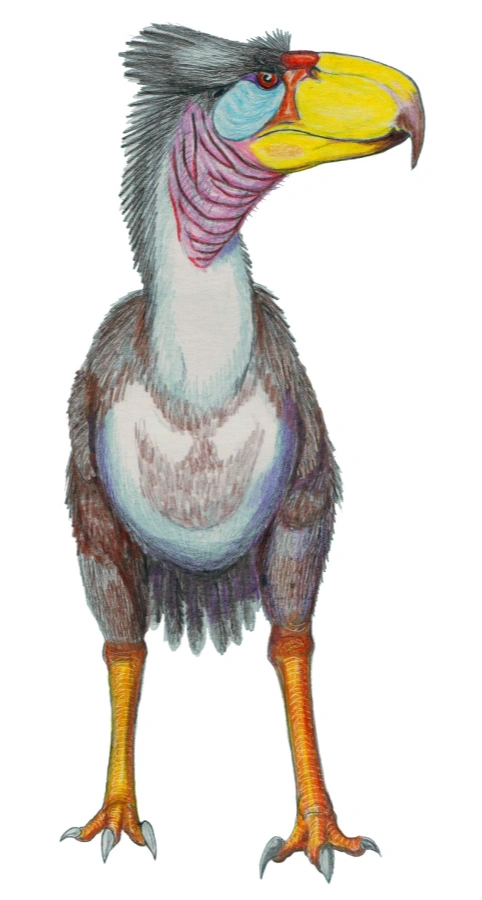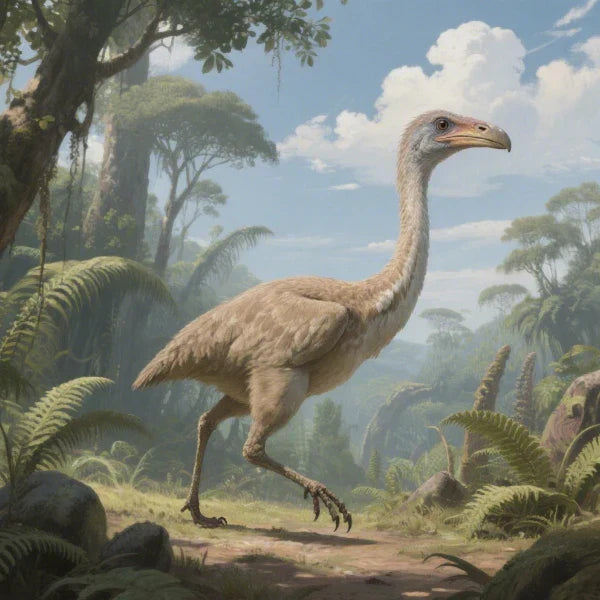Terror birds (Phorusrhacidae) were giant, flightless predators that once ruled South America. With sharp beaks, powerful legs, and forward-facing eyes, they hunted with speed and precision, earning their fearsome name. These birds emerged after the extinction of dinosaurs and dominated their ecosystems for millions of years.
In this article, we explore the rise and fall of these apex avian predators. From anatomy to extinction, we’ll uncover their terrifying legacy and the wild birds that still carry their shadow today.

Image by ДиБгд, via Wikimedia Commons, licensed under CC BY 4.0.
What Were Terror Birds?
Before we dive into the fossil record, imagine what it might have felt like to stand in their shadow. You're on the trip of a lifetime, backpacking in Patagonia. Torres del Paine is everything they said: broken-up granite peaks, serene lakes, endless sky. As your group hikes along the trail, you veer off onto a side trail down a dry creek bed.
The wind dies down. No birds are singing, and no footsteps can be heard, only a strange stillness. Suddenly, there is a thud, followed by another. The earth feels soft beneath you. Something is approaching.
You turn around. The first thing you see is its feet, three thick toes with claws digging deep into the dry earth. Scaled legs emerge from them, tense and built for speed. Ragged feathers hang from its sides like frayed armor. Its chest rises and falls slowly, rhythmically. Then, it lifts its head. The skull is massive, with a curved beak like a butcher's cleaver. Its eyes are fixed on you, dark and forward-facing. It does not scream. It does not flee. It does not need to. It simply waits.
At that moment, you recall something you read earlier that morning. The guide had mentioned Phorusrhacidae; the so-called terror birds. Towering, wingless predators that once ruled this very ground. But now? You're gazing at the past with living eyes.

A Taxonomic Snapshot: Classification and Evolution
Terror birds were members of the extinct Phorusrhacidae family. They were a group of big, flightless predatory birds that belonged to the Cariamiformes order. They first appeared around 60 million years ago, shortly after the dinosaurs became extinct. They thrived until approximately 1.8 million years ago, although some fossils suggest that they may have survived in isolated regions beyond that time.
Fossil evidence is more abundant in South America, particularly Argentina and Uruguay. The closest living relatives are South American seriemas. They are large, terrestrial birds that hunt small animals on foot. Although seriemas are much smaller, they offer valuable insights into the behavior of these ancient species.
Meet the Monsters: Distinguished Genera and Their Contribution
Terror birds weren't a single, isolated species; they were an assassination clan. Let's meet some of the most notorious among them.
Phorusrhacos longissimus: The Classic Killer
Standing approximately 2.4 meters tall with a skull measuring 65 cm, Phorusrhacos was one of the most well-known terror birds. It existed during the Miocene epoch in Argentina. It was swift and gruesome, likely employing bursts of speed to catch prey off guard. While its massive, axe-shaped beak delivered a powerful impact.

Image Source: Illustration of Phorusrhacos by Charles R. Knight.
Kelenken guillermoi: The Skull King
Kelken has the biggest recorded bird skull ever discovered, measuring a full 71 cm. This bird features a long, thin, blade-like beak that is ideal for slicing. Fossil evidence indicates it was similar to a turkey but much faster. It likely raced across broad grasslands to catch prey before delivering a fatal bite.

Titanis walleri: The Northern Invader
Titanis is the only terror bird that ventured up into North America. Standing about 2.5 meters tall, it appeared relatively late in the fossil record and was found in Florida. It is believed to have been an immigrant from South America across the Great American Biotic Interchange. Despite its power stature, Titanis might have been pushed out by large mammalian predators.

Image by Dmitry Bogdanov, via Wikimedia Commons, licensed under CC BY-SA 3.0.
Brontornis burmeisteri: The Giant Heavyweight
Reaching an incredible 400 kg, Brontornis may have been the biggest bird to have ever lived. Whether or not it actually belonged to the Phorusrhacidae family is debatable. However, its heavy bones suggest that it was built more for brute power than velocity.

Image by Agustín Agnolin, via Wikimedia Commons, licensed under CC BY 4.0.
Llallawavis scagliai: The Most Complete Picture
This species offered researchers the clearest view of a terror bird's entire body. Found in nearly pristine condition, Llallawavis revealed an important detail: it had low-frequency hearing. That means it would have probably been able to detect prey or rivals hundreds or thousands of meters away.

Image by Rextron, via Wikimedia Commons, licensed under CC BY-SA 4.0.
Andalgalornis steulleti: The Precision Striker
Terror birds weren't all giants. Andalgalornis was smaller but was equipped with a strong, armor-like skull perfectly suited to repeated, glancing blows. It likely employed a "hit-and-retreat" tactic, darting in and out to weaken its victim before delivering the final blow.

Image by John Conway, via Wikimedia Commons, licensed under CC BY-SA 3.0.
Anatomy of Violence: Predatory Adaptations
Terror birds were built with a lethal intention, not just to appear dangerous. Their beaks were vertical, deep, and sturdy, allowing for powerful strikes. Unlike living raptors that crush and tear sideways, Phorusrhacids likely used their beaks to impale prey with brutal downward blows.
The necks of these birds played a key role in their lethal movement. These birds had heavily rooted neck muscles and bifurcated vertebrae, which enabled them to deliver powerful, quick "hatchet blows." Their legs served as powerful weapons. They were long and sturdy, with rigid lower joints that provided sprinting power and a firm foundation for charge attacks. While their wings shrunk over time, they were still functional.
Their brains were adapted for sight, not for smell. Fossil endocasts of their brain cases show powerful visual processing. This binocular vision is ideal for seeing running prey. However, their olfactory lobes were relatively primitive. These birds didn't sniff you out. They saw you, stalked you, and struck when you weren't aware they were approaching.

Image by Amanda (via Flickr), via Wikimedia Commons, licensed under CC BY 2.0.
Terror Bird Growth and Reproduction Explained
While no fossilized eggs have been specifically linked to terror birds, they're believed to have nested on the ground. Their chicks would've been precocial, meaning they hatched with their eyes open and were able to run right away. This capability would've been a requirement in open habitats full of predators.
Bone histology studies show that terror birds grew rapidly, reaching near-adult size in just a few years. This rapid growth suggests a high-energy lifestyle and an evolutionary pressure to grow fast. Some paleontologists have speculated that both parents may have been involved in defending and raising chicks. However, there is no fossil evidence.

Habitat and Evolutionary Background of Terror Birds
For most of the Cenozoic Era, South America was a biological island, completely isolated from the other continents. Without placental mammals as predators, a new top predator species arose: the terror bird.
Early forms of terror birds likely hunted in wooded habitats, using heavy cover to ambush prey. However, as the Miocene climatic changes transitioned to open grasslands, terror birds evolved longer legs, slimmer bodies, and greater speed. They became cursorial, enabling them to pursue prey more effectively rather than relying on ambush tactics.
The majority of terror bird fossils lie in Argentina and Uruguay. However, a few signs point to them being present in other regions. Titanis walleri infamously migrated into North America around 5 million years ago, coinciding with changes to the land bridges that connected the continents.

Photo by Hans Isaacson on Unsplash
Extinction of Terror Birds: The End of the Line
By around 1.8 million years ago, the reign of terror birds was coming to an end. Most of the large-bodied genera like Phorusrhacos and Kelenken had vanished. They were unable to withstand the rapid changes occurring in South America. Some small species like Psilopterus lasted a bit little longer, but the days of bird top predators were over.
Ultimately, the invasion of North American predators during the Great American Biotic Interchange was catastrophic for these massive birds. Once South America reunited with the North, terror birds were outcompeted for resources, leading to the decline of their dominance.

Image by Jonathan Chen, via Wikimedia Commons, licensed under CC BY-SA 4.0.
Conservation Echoes: Lessons from the Lost Giants
The terror birds used to rule South America's open grassland with their speed, strength, and formidable beaks. Yet, they were extinct. Their extinction reminds us that even the ruling predator is not exempt from change. Factors such as climate change, habitat loss, and the introduction of new species were all responsible for their extinction.
Today, most groundbirds face similarly eerie threats. The Australian cassowaries, African ground hornbills, and South American seriemas are losing their habitats and competing with invasive species. They might not be ten feet tall, but their role in the ecosystem is just as vital.
Organizations like BirdLife International, EDGE of Existence, and the IUCN are working to preserve these modern-day relics. They focus on efforts like habitat preservation, breeding programs, and community engagement.
Additionally, advances in technology have also brought new opportunities for bird protection. Technologies like smart bird feeders are becoming part of the solution. These devices allow scientists to monitor stress behaviors, consumption patterns, and local biodiversity without disrupting the birds. The terror birds have vanished, but their story is hardly finished. It calls to us to rescue the species that continues to struggle for survival today.

Final Thoughts
As we cut back to you in that Patagonian creek bed, your eyes are tightly shut. When your eyes open again, the creek bed is empty. The shape you'd sworn was there, those long legs, the tattered feathers, those iron eyes have vanished. The only noises now are the wind through the grass and your breathing, thin and ragged. You turn slowly, glancing down the ridgeline, but there is no sign of movement.
However, there is something else. The air tastes different. You remember the stories. Terror birds were no myth. They had been real, prime predators who ruled South America for millions of years. They didn't roar; they didn't need to. Their presence alone was enough.
Their bones sleep in fossil beds, and their legacy lingers in flying birds that brood over the forest floor. Something in the air still holds their presence. You let out a nervous breath, attempting to shrug it off, thinking maybe you dreamed it. Maybe you didn't. You press on, but you still glance sideways, just in case.

Photo by Zachary on Unsplash
FAQs About Terror Birds
Are terror birds dinosaurs?
Not really. Terror birds (Phorusrhacidae) were not dinosaurs in the traditional sense, as true dinosaurs were extinct around 66 million years ago. However, terror birds were part of the avian branch that evolved from theropod dinosaurs.
Could terror birds fly?
Not at all. These birds never flew. Most of them possessed vestigial, tiny wings that were too small to provide any lift. Some of the smaller species might have used their wings for balance or to display threats. However, gliding or flight was impossible.
Which terror bird was the largest?
That honor goes to Kelenken guillermoi, which had the largest known bird skull, measuring nearly 28 inches long in length. However, Brontornis burmeisteri may have weighed more overall, though its classification as a Phorusrhacidae is disputed.
Are any terror birds still alive today?
No terror birds exist today, but the South American modern seriemas are their closest living descendants. These ground-foraging birds share similar behavior and anatomical features.
What wiped terror birds out?
Their extinction was likely due to several factors, including climate change and habitat shifts. Also, the introduction of large mammalian carnivores during the Great American Biotic Interchange contributed to their decline. These new predators likely pushed out the terror birds.




Leave a comment
All comments are moderated before being published.
This site is protected by hCaptcha and the hCaptcha Privacy Policy and Terms of Service apply.